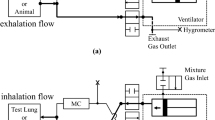Abstract
The present experiments investigated the effects of 1 and 12 atmospheres absolute (ATA) helium-oxygen on potentially lethal doses of ethanol given alone or in combination with pentobarbital. Drug-naive, male C57BL/6J mice were injected IP with 5.4–6.5 g/kg ethanol, 4.5–6.9 g/kg ethanol plus 20 mg/kg pentobarbital, or 50–110 mg/kg pentobarbital plus 2.5 g/kg ethanol. Following injection, the mice were placed into chambers and exposed to environments of 1 ATA air, 1 ATA helium-oxygen, or 12 ATA helium-oxygen. Exposure to 1 or 12 ATA helium-oxygen significantly reduced the lethal effect (percent mortality at given doses and LD50) of ethanol given alone or with 20 mg/kg pentobarbital when compared to animals exposed to 1 ATA air. The pattern and degree of reduction in lethality for the 1 and 12 ATA helium-oxygen treatments were similar, suggesting that the antagonism resulted from increased helium or decreased nitrogen and not from increased atmospheric pressure. Exposure to these environments did not reduce lethality in mice given 2.5 g/kg ethanol in combination with relatively high doses (50–110 mg/kg) of pentobarbital. These findings suggest that helium-oxygen breathing mixtures may be useful in the treatment of some overdose patients.
Similar content being viewed by others
References
Alkana RL, Malcolm RD (1980) Antagonism of ethanol narcosis in mice by exposure to hyperbaric pressures of 4–8 atmospheres. Alcoholism 4:350–353
Alkana RL, Malcolm RD (1981) Low level hyperbaric ethanol antagonism in mice: Dose and pressure response. Pharmacology 22:199–208
Alkana RL, Malcolm RD (1982a) Hyperbaric ethanol antagonism in mice: Studies on oxygen, nitrogen, strain and sex. Psychopharmacology 77:11–16
Alkana RL, Malcolm RD (1982b) Hyperbaric ethanol antagonism in mice: Time course. Subst Alcohol Actions Misuse 3:41–46
Alkana RL, Noble EP (1979) Amethystic agents: Reversal of acute ethanol intoxication in humans. In: Majchrowicz E, Noble EP (eds) Biochemistry and pharmacology of ethanol, vol II. Plenum, New York, pp 349–374
Anonymous (1980a) Poisoning deaths in the United States in 1977. Bulletin, National Clearinghouse for Poison Control Centers, DHEW, 24:2–7
Anonymous (1980b) Deadly duo still number one killer. Am Pharm 20:15
Beaver RW, Brauer RW, Lahser S (1977) Interaction of central nervous system effects of high pressures with barbiturates. J Appl Physiol 43:221–229
Bennett PB (1975) Inert gas narcosis. In: Bennett PB, Elliot DM (eds) The physiology and medicine of diving and compressed air work. Williams and Wilkins, Baltimore, pp 207–230
Brauer RW, Way RO (1970) Relative narcotic potencies of hydrogen, helium, nitrogen and their mixtures. J Appl Physiol 29:23–31
Erickson CK (1983) Amethystic agents in the treatment of alcohol intoxication. In: Kissin B, Begleiter H (eds) The pathogenesis of alcoholism. Plenum, New York, pp 591–611
MacInnis J, Dickson JG, Lambertson CJ (1967) Exposure of mice to helium-oxygen at pressures to 122 atmospheres. J Appl Physiol 22:694–698
Malcolm RD, Alkana RL (1981) Temperature dependence of ethanol depression in mice. J Pharmacol Exp Ther 217:770–775
Malcolm RD, Alkana RL (1982) Hyperbaric ethanol antagonism: Role of temperature, blood and brain ethanol concentrations. Pharmacol Biochem Behav 16:341–346
Malcolm RD, Alkana RL (1983) Temperature dependence of ethanol lethality in mice. J Pharm Pharmacol 35:306–311
Membery JH, Link EA (1964) Hyperbaric exposure of mice to pressures of 60 to 90 atmospheres. Science 144:1241–1242
Miller KW, Wilson MW (1978) The pressure reversal of a variety of anesthetic agents in mice. Anesthesiology 48:104–110
Snyder SH (1984) Drug and neurotransmitter receptors in the brain. Science 224:22–31
Stern SA, Frisch HL (1973) Dependence of inert gas narcosis on lipid free volume. J Appl Physiol 34:366–373
Tobey RE, McCracken LE, Small A, Homer LD (1978) Effect of hyperbaric helium of anesthetic action of thiopental. In: Shilling CW, Beckett MW (eds) Proceedings of sixth symposium on underwater physiology. FASEB, Bethesda, pp 267–272
Author information
Authors and Affiliations
Rights and permissions
About this article
Cite this article
Malcolm, R.D., Finn, D.A., Syapin, P.J. et al. Reduced lethality from ethanol or ethanol plus pentobarbital in mice exposed to 1 or 12 atmospheres absolute helium-oxygen. Psychopharmacology 86, 409–412 (1985). https://doi.org/10.1007/BF00427900
Received:
Accepted:
Issue Date:
DOI: https://doi.org/10.1007/BF00427900




